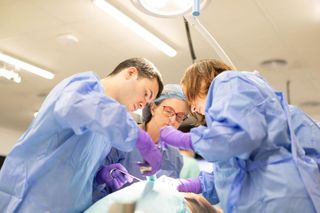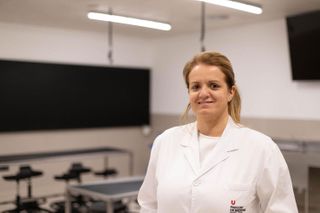- The UVic-UCC Faculty of Medicine hosts this service, which allows the study of human anatomy through the use of embalmed and cryopreserved bodies
- The laboratory benefits directly from the Body Donation to Science service, which was set up five years ago
In the nineteenth century, when human dissection was not available to everyone, medical students discovered what human anatomy looked like with the help of anatomical figures made with plaster and wax. These were similar to the figures exhibited in the showcases of the University of Vic - Central University of Catalonia (UVic-UCC), which is a secondary site of the Museum of the History of Medicine of Catalonia, created as a result of an agreement between the College of Doctors of Catalonia, the Museum of the History of Medicine of Catalonia and the Foundation for Advanced Studies in Health Sciences (FESS).
A lot of progress has been made in the knowledge of human anatomy and in the precision of surgical interventions. This is largely due to services such as that of the Anatomy Laboratory of the UVic-UCC’s Faculty of Medicine. Here, health sciences students from the UVic-UCC’s Vic, Manresa and Medicine campuses, and working health professionals, can learn, practice and improve their training thanks to the people who have given their bodies to science altruistically through the Donating your Body to Science service of the UVic-UCC’s Faculty of Medicine. Since the conception of the Faculty of Medicine, the creation of FESS in 2015, and the start of the degree in Medicine in 2017-2018, “the body donation to science programme has been a priority to offer face-to-face and virtual anatomy teaching, using the Sectra system, in the Dissection Laboratory,” explained Josep Arimany, president of FESS.
“The body donation to science programme was a priority to offer face-to-face and virtual anatomy teaching, using the Sectra system, in the Dissection Laboratory”
In the 2022-2023 academic year, around a thousand people, from Catalonia, Spain and other countries (via online broadcasts), completed some type of training at the UVic-UCC Anatomy Laboratory, which currently has capacity for thirty bodies. This laboratory is available to all society, but mainly to health sciences students of this university (degrees in Medicine, Physiotherapy, Nursing, Podiatry, Dentistry and the UVic-UCC-specific degree in General Audiology, among others) to deepen the study of anatomy.

In the case of the degree in Medicine at the UVic-UCC, students in the 1st and 2nd year (Basic Cycle) take anatomy subjects in this laboratory with previously embalmed and dissected bodies. From the 3rd year up to the 6th year (Clinical Cycle), cryopreserved bodies are used as a teaching resource in several subjects. Students learn, for example, how to do thoracentesis, laparotomies, gynaecological examinations and cervical cancer sampling, joint injections, etc. “These workshops with cryopreserved bodies, which all the Clinical Cycle students take, are not held in any other Faculty of Medicine,” noted Laia Nogué, director of the Anatomy Laboratory and the Body Donation Service at the UVic-UCC Faculty of Medicine.

Training and research
Another group that uses the UVic-UCC Anatomy Laboratory are doctors who are already working in the medical profession and residents who are being trained in their specialty, who come from health centres in Catalonia and Spain. “They come to the lab to practice certain surgical techniques on cryopreserved lifeless bodies before practicing them on real, living patients. In this way, they can try procedures, practice and gain confidence before entering the theatre to operate,” explained Nogué.

By areas or specialities, this laboratory is mainly used for general surgery - especially to practice laparotomies and laparoscopies - for traumatology and for podiatry. Lifeless bodies available in the Anatomy Laboratory are also used for research, development and innovation purposes, for example to test the fit of certain prostheses to the human body before fitting them in patients.
Five years of the Body Donation to Science service
The Faculty of Medicine’s Anatomy Laboratory benefits directly from the Body Donation to Science service, which was created five years ago in February 2018. In October 2023, the service had a total of 680 people registered, among whom there were more women than men. By age, the largest group was between 60 and 79 years old. Regarding deaths, Laia Nogué noted that “every year more people enter the service and up to this October a total of 100 people had died out of all those who had donated their bodies from the beginning until now.” The age range of most deaths is between 80 and 89 years. Notably, in the first years of the service, the time that elapsed between people being registered and death was between 1 and 3 months.
In 2020, a unique and pioneering space was created in the Vic municipal cemetery, the Marie Curie Garden, where the ashes are deposited of all the people who have given their bodies to science at the Faculty of Medicine
Body donation to science is a voluntary, free, altruistic act, and it can be done by any person of legal age who is in full use of their mental faculties. Only bodies on which an autopsy has been performed and/or of patients who have had Hepatitis B, Hepatitis C or AIDS cannot be used. As a tribute and in gratitude to the donors, and as a place of remembrance for their families, in 2020 a unique and pioneering space was created in the Vic municipal cemetery, the Marie Curie Garden. Here the ashes are deposited of all the people who have given their bodies to science at the Faculty of Medicine. This is also a space designed for the donor's relatives and friends, where they can mourn or leave flowers.
The agreement between the Faculty of Medicine and the City Council of Vic - with the councillor responsible at the time who is now the Mayor of Vic, Albert Castells - made it possible to have this “unique and singular space for the donors’ families,” remembers Josep Arimany. “Families are grateful to have this place and some people value it as a decisive factor in making the donation in Vic”, adds Nogué.

“We improve the safety of patients and the confidence of resident doctors”
Roser Farré, assistant in General Surgery and the Digestive System at Althaia Xarxa Assistencial and professor at the UVic-UCC Faculty of Medicine
“Having an anatomy laboratory means that this subject can be studied directly from the human corpse, which is therefore highly representative of reality. It allows the teachers and students to identify structures and see their anatomical relationships; the student can touch the part and learn better. Furthermore, practicing surgical anatomy using cryopreserved bodies is very similar to working on living beings, in terms of texture, and this means that resident doctors can learn new surgeries that they may have never or rarely practiced. Thus, when these techniques are carried out on patients, the doctor will already have a little more experience. This improves patient safety and the confidence of resident doctors”.

“Practicing with a corpse gives you everything that books do not”
Oleksandr Yashchenko, 4th year resident of Orthopaedic Surgery and Traumatology at the Vic Hospital Consortium (CHV)
“Being able to train in the Anatomy Laboratory is an invaluable opportunity, because as doctors dedicated to surgery, our knowledge base is anatomy. It has benefitted me greatly to be able to optimize everything that affects the patient; practicing with a corpse gives you everything that books do not. Above all, it has helped me to put approaches into practice - for example, in a wrist operation, knowing where to cut because it is very important not to damage nerves - and to get to know better, from both cryopreserved and embalmed bodies, which structures we can find. We are lucky to have this space in Vic; there are few hospitals that have this kind of service so close”.

“From the second month of Medicine we enter the laboratory and look, touch and learn”
Raúl López, 6th year student of the UVic-UCC degree in Medicine
“When we start the first year of the bachelor’s degree in Medicine we have no experience with the human body, but from the second month we enter the laboratory and look, touch and learn anatomy with corpses and embalmed body parts. The truth is that it is a very beneficial resource, because not everyone has this service in the same faculty. Yes, it is shocking to see a body and think that it belongs to someone who has died, but it is mostly a moral feeling. In the Clinical Cycle we have done a wide range of practical sessions, from bowel and liver examinations, to thoracic punctures to drain fluid or air from between the lungs, which was very useful to me. I want to work in Emergency and chest drainage, for example, is an action that is practiced in a serious situation in which you have to be quick”.

“Friends are stunned and say: ‘And do you like doing that?’”
Neu Marzal, a 2nd year student in the Pathological and Cytodiagnostic Anatomy higher education cycle at IES Narcís Xifra in Girona, is doing curricular practices at the UVic-UCC Anatomy Laboratory
“We have a subject called Necropsies, in which they teach us anatomy, types of openings when performing autopsies and instruments, and that's why I come to the laboratory of the Faculty of Medicine, although I'm still not sure whether to choose nursing or the forensic field. Two years ago I came to see the laboratory and saw parts of a body; this gave me a lot of respect, but it is also true that it is a very unknown subject. Friends are stunned and say: “And do you like doing that?” What I do is dissect body parts, which consists of removing the fat and leaving the blood vessels, nerves, muscles... so that the medical students can use them. Here you really see what it means to give your body to science, because thanks to this gesture people can study and learn better, because there is nothing like seeing it with your own eyes”.